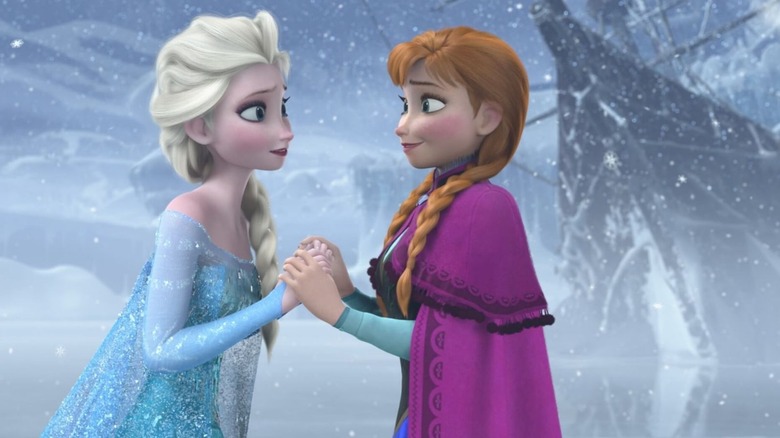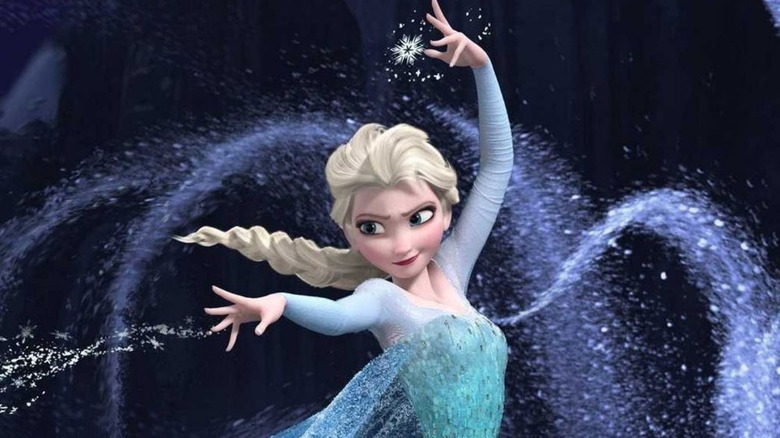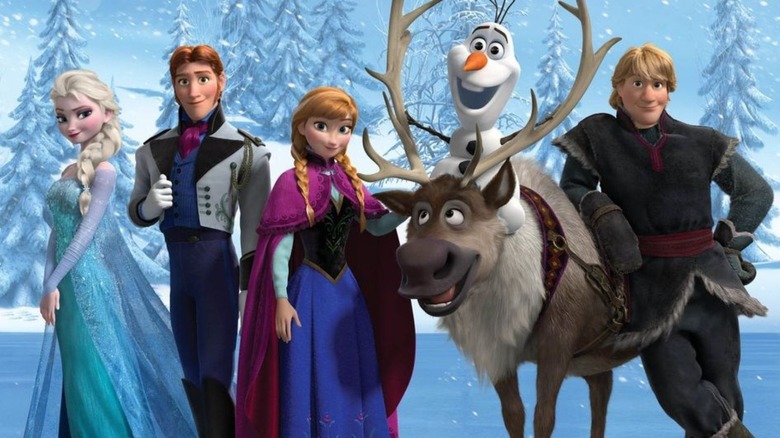Disney's Frozen Was Originally A Much Darker Story
Disney's "Frozen," one of the most successful animated movies in history, was almost a completely different film. It had a much darker plot, one of its leading heroes was a villain, and the final act wasn't as heart-warming, either. Instead of Elsa and Anna's sisterly affection becoming the latter's act of true love, "Frozen" was written to conclude with a massive avalanche and an army of snow monsters, all happening while the two sisters fought each other. The animated film featured a good vs. evil theme, and in fact, Elsa and Anna weren't even supposed to be sisters.
"Frozen" producer Peter Del Vecho revealed to Entertainment Weekly that in the original version of the film, Elsa freezes her own heart after being stood up at the alter and was a self-proclaimed snow queen. And she was pure evil. Neither Elsa nor Anna were royalty — or even related. Kristen Bell (who voiced Anna) previously told fans that Elsa was a straightforward villain, but Del Vecho detailed how Elsa's character development changed the film's ending forever and was instrumental in making "Frozen" the success it went on to be.
Frozen Went Through Many Iterations
As per producer Del Vecho, every film the "Frozen" team has worked on led them in a different direction than their preconceived notions. If they were clever enough to see it through, the movie would end up being a lot more different than planned. While working on "Frozen," the creative team decided to make a movie about Elsa, an evil female villain, and Anna, an innocent female heroine. The two were pitted against each other in an ending involving an epic battle of sorts, with a last-minute redemption plot and the introduction of another character who had been the big bad all along.
Initially, the film began with a prophecy: "A ruler with a frozen heart will bring destruction to the kingdom of Arendelle." Anna is a pure-hearted heroine, much like her character in the final version, but Elsa is evil incarnate. The latter gets stood up on her wedding day and freezes her heart so she may never love again. At this time, both the audience and Elsa assume the prophecy is about her — and here comes the plot twist.
During the final act, Elsa creates an army of snow monsters to attack the heroes. Kristoff has a "Han Solo moment" and arrives to assist Anna. Remember Prince Hans? The arrogant, power-hungry fella who betrays Anna? The two-faced Prince decides to halt Elsa's monster army and triggers a massive avalanche, putting everyone in the great kingdom in jeopardy. Anna, realizing that Elsa is their only hope, persuades her to use her powers to save Arendelle. It turns out that Prince Hans is the one with the metaphorical frozen heart and not Elsa, and it's fitting because he is villain material. Following Elsa's redemption arc, her frozen heart is thawed, and she finds herself able to love once again.
It Wasn't Good Enough
I don't doubt that Disney would be able to pull off evil Elsa's redemption act and Hans being the big bad and everything, and it would be pretty cool to see snow monsters, to be honest. But the concept wasn't good enough for Disney — it didn't feel original to them. Del Vecho admitted, "The problem was that we felt like we had seen it before." It wasn't a satisfying story, and they didn't share an emotional connection with Elsa — she had spent the entire movie being a villain. They disagreed that the dark ending would be successful in drawing viewers.
"Frozen" directors Chris Buck and Jennifer Lee then began asking pressing questions about Elsa and Anna — and their relationship. Did Elsa have to be a villain? And what if the two were sisters instead?
"Making them [sisters] related led us to the idea of her living in fear of her powers," Del Vecho added. "What if she's afraid of who she is? And afraid of hurting the ones she loves? Now we had a character in Anna who was all about love and Elsa who was all about fear. That led to making Elsa a much more dimensional sympathetic character, and instead of the traditional good vs. evil theme we had one that we felt was more relatable: Love vs. fear, and the premise of the movie became that love is stronger than fear."
The filmmakers eventually decided that an act of true love would bring sunshine back to Arendelle, teach Elsa to control her magic, and save Anna's life — but in an unconventional way. The greatest thing about "Frozen" is that it emphasizes the love and affection shared by Anna and Elsa as sisters and doesn't require either of them to be rescued by men. They save each other.
After the third act was set, story artist John Ripa created the storyboard for the scene, visualizing Elsa's emotions to create a white blizzard. It made a perfect setting that isolated Hans, Elsa, and Anna from Kristoff, whose kiss viewers assumed was the "act of true love" that'd stop Anna from freezing solid. Instead, Anna shields Elsa right when Hans is about to kill her, in the act of true love, which later causes her icy form to thaw out. "Frozen" would be very different if the filmmakers decided to go with the original, darker ending. But fortunately for us, they were able to give us the best version we could've asked for!


